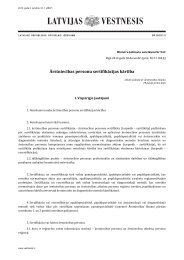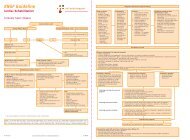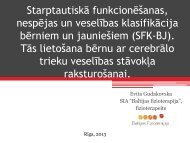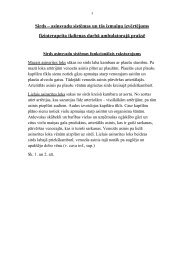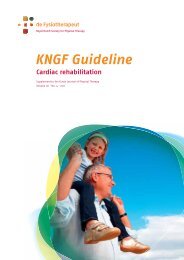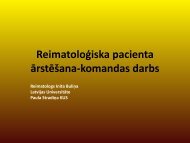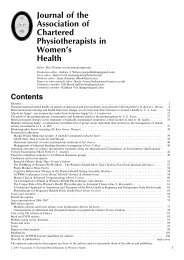Create successful ePaper yourself
Turn your PDF publications into a flip-book with our unique Google optimized e-Paper software.
<strong>Low</strong> <strong>Back</strong> <strong>Pain</strong>: Clinical Practice Guidelines<br />
Judgments of Centralization During Movement Testing<br />
ICF category Measurement of impairment of body function – pain in back; pain in lower limb; and mobility of several joints<br />
Description Clinician judges the behavior of symptoms in response to movement testing to assess whether centralization or peripheralization<br />
occurs. Judgments of centralization require that an accurate assessment of the patient’s baseline location of symptoms is made,<br />
followed by the precise application of active or passive movements and the associated assessments of any changes in the patient’s<br />
baseline location of symptoms in response to the movements. Centralization occurs when the location of the patient’s symptoms, such<br />
as pain or paresthesias, is perceived by the patient to be in a more proximal location in response to single and repeated movements or<br />
sustained positions. Peripheralization occurs when the location of the patient’s symptoms is perceived in a more distal location, such<br />
as the calf or foot, in response to single and repeated movements or sustained positions.<br />
Measurement method Patient is asked to flex and extend in the sagittal plane, or laterally shift the pelvis and trunk in the frontal plane, in standing, supine,<br />
and prone with single and repeated movements in a systematic fashion. When appropriate, the clinician can manually guide the<br />
movements of the patient and apply passive overpressures to the movements. Judgments are made with regard to which movement,<br />
if any, produces centralization of the patient’s symptoms.<br />
Nature of variable Categorical<br />
Units of measurement Present/absent<br />
Measurement properties Kappa coefficients are reported to be 0.70 to 0.90 for novice and experienced physical therapists. 109,181<br />
Instrument variations Techniques to improve the precision of these judgments have been described, including strategies to discriminate between<br />
centralization and directional preference responses. 314 However, the practicality of using these strategies has not been demonstrated.<br />
Prone Instability Test<br />
ICF category Measurement of impairment of body function – pain in back; pain in lower limb; mobility of joint functions, specified as mobility in a<br />
vertebral segment, control of complex voluntary movements<br />
Description The patient lies prone with the body on the examining table, legs over the edge and feet resting on the floor. While the patient rests in<br />
this position, the examiner applies posterior-to-anterior pressure to spinous processes of the lower portion of the lumbar spine. Any<br />
provocation of pain is noted. Then the patient lifts the legs off the floor (the patient may hold table to maintain position) and posteriorto-anterior<br />
pressure is again applied to the lumbar spine.<br />
Measurement method If pain is present in the resting position but subsides substantially (either reduces in severity/intensity or resolves) in the second<br />
position, the test is positive. Mild improvement in symptoms does not constitute a positive test. If pain is present in the resting position<br />
but does not subside substantially in the second position, the test is negative. Further, if the patient did not have any pain provocation<br />
with posterior-to-anterior pressures applied to the lumbar spine, then the test is judged “negative.”<br />
Nature of variable Categorical<br />
Units of measurement Positive or negative<br />
Diagnostic accuracy and<br />
measurement properties<br />
Good to excellent agreement reported (κ = 0.87) 153 for 3 pairs of physical therapy raters evaluating 63 consecutive subjects currently<br />
experiencing low back pain and with a previous history of low back pain. As an independent test the Prone Instability Test has limited<br />
diagnostic use (+LR = 1.7 [95% CI: 1.1, 2.8]; –LR = 0.48 [95% CI: 0.22, 1.1]) 152 ; however, it may be most useful as a component of a<br />
cluster of tests to predict response to motor control exercises. 152<br />
Judgments of the Presence of Aberrant Movement<br />
ICF category Measurement of impairment of body function – pain in back; pain in lower limb; mobility of several joints; and control of complex<br />
voluntary movements.<br />
Description “Aberrant movement” includes the presence of any of the following: painful arc with flexion or return from flexion, instability catch,<br />
Gower sign, and reversal of lumbopelvic rhythm.<br />
Measurement method <strong>Pain</strong>ful arc with flexion or return from flexion is positive if the patient reports pain during movement but not at the end ranges of the<br />
motion.<br />
Instability “catch” is positive when patient deviates from straight plane sagittal movement during flexion and extension.<br />
Gower sign is positive if the patient needs to utilize “thigh climbing” on return from flexion, specifically, the hands push against the<br />
anterior thighs in a sequential distal to proximal manner to diminish the load on the low back when returning to the upright position<br />
from a forward bent position.<br />
Reversal of lumbopelvic rhythm is positive if the patient, upon return from a forward bent position, suddenly bends his/her knees to<br />
extend the hips, shifting pelvis anteriorly, as he/she returns to the standing position.<br />
(continued)<br />
a24 | april 2012 | volume 42 | number 4 | journal of orthopaedic & sports physical therapy



